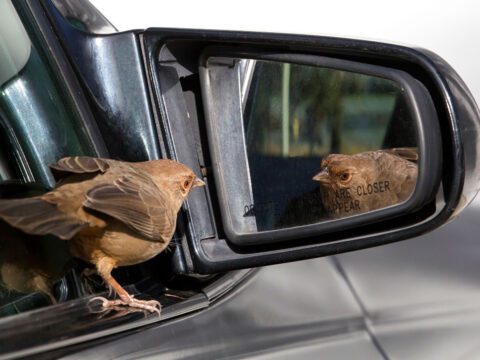Behind the Scenes of Imperial Dreams: A Pennsylvania Dentist in the Mountains of Mexico
By Tim Gallagher, Editor-in-Chief, Living Bird April 17, 2013

I’ve always loved the story of William Rhein—the indefatigable Imperial Woodpecker searcher who launched three self-funded expeditions into the vast Sierra Madre of Mexico in the 1950s to try to document these remarkable birds as they hovered even then at the edge of extinction. I sometimes wonder why he did it. Rhein had an excellent income from his dental practice in Harrisburg, Pennsylvania; a nice home; and no children, so he and his wife could afford to indulge themselves in every way. But instead he chose to drive south with a few buddies and spend up to two months at a time, roughing it in the outback of Mexico, living on beans, booze, and tortillas.
Of course, it was a great adventure. These guys were World War II veterans, and perhaps they missed the thrills, danger, and sense of camaraderie they’d experienced in combat. And bird study was a lifelong obsession with Rhein. Although he did not have a degree in ornithology, he was an ornithologist to the core—and also a gifted bird photographer and cinematographer. Rhein’s lucrative dental practice provided all the funds and time he needed to do anything he wanted, and the Imperial Woodpecker was the ideal species for an obsessive quest—a bird that had barely been studied and never photographed alive. Perhaps it was the challenge of accomplishing something that had never been done that spurred him on.
In the course of working on my new book, Imperial Dreams, I was fortunate enough to interview two surviving members of Rhein’s expeditions—Frederick K. Hilton (who went with him in 1953) and Dick Heintzelman (who went in 1956)—and they filled me in on the details of the expeditions and shared their photographs with me.
The first thing Rhein did to prepare for his expedition was to visit famed Cornell professor Arthur A. Allen (founder of the Cornell Lab of Ornithology), who had searched for Imperial Woodpeckers in 1946. Allen—along with his wife Elsa and 20-year-old son David—had spent six weeks in Mexico, driving the atrocious mountain roads in a station wagon and a sedan, both laden to the gunwales with camera and sound-recording equipment. They actually located one of the birds, a lone female, but were unable to photograph it or make a sound recording. Allen was generous to Rhein, providing him with maps, advice on where to go, and the names of people to contact in Mexico. He even loaned Rhein a huge parabolic microphone and a wire recorder (an early sound-recording device that recorded sound onto thin steel wire) in case he got a chance to document the bird’s voice, which had also never been done.
Rhein and three of his friends loaded up his Chevy panel truck with all of their gear and headed south in the late spring of 1953, driving all the way from Harrisburg, Pennsylvania, to the city of Durango, Mexico, some 2,500 miles away. Although they struck out in the first two areas they explored, the men eventually found several Imperial Woodpeckers (including a pair with two young) near Los Laureles, a tiny village in the high country of Durango.


Some of the local people were suspicious of the strange equipment they carried, such as the odd-looking metal parabola, which was bigger around than a sledding disk, and the wire recorder. This was in the early days of the nuclear age, and some of them suspected the Americans were searching for uranium.
The sound-recording equipment proved to be impractical for the job at hand. They brought along six truck batteries to power the setup, which did not allow them the mobility they needed to follow an Imperial Woodpecker closely and record its call—which is too bad; no recording of the bird’s voice exists, and no one has ever had a better chance to record it than Rhein and his friends. They were also unable to take still photographs or film footage on this or their follow-up expedition in 1954.
On his third and final expedition to Mexico in 1956, Rhein finally successfully documented an Imperial Woodpecker, capturing a variety of behaviors on 85 seconds of 16-mm Kodachrome motion-picture film. But unfortunately, the film didn’t meet Rhein’s strict professional standards, and he kept it to himself for decades. He had filmed the segment from the back of a mule as the woodpecker hung around, flying from tree to tree in a circle, and occasionally foraging.


The world might very well never have learned about Rhein’s Imperial Woodpecker film if not for the efforts of my colleague Martjan Lammertink, who tracked down Rhein and interviewed him less than two years before his death. Martjan had read a letter in the Cornell archives that Rhein had written to woodpecker researcher James Tanner in the early 1960s, in which he had briefly mentioned the Imperial Woodpecker footage he shot in Mexico. Martjan was living in the Netherlands at the time, but the next time he came to America, he tracked down Rhein at his home in Pennsylvania.
Rhein and his wife greeted Martjan warmly and invited him inside. Later, they sat down in the living room and Rhein set up his old 16-mm projector and screen and began running the film. Martjan had the foresight to turn on a tape recorder as he sat with them as the projector rolled. Pat Leonard at the Cornell Lab has put together some of Rhein’s best footage and used the conversation between Rhein and his wife and Martjan as a voiceover. You can view it here:
I love hearing the comments of Rhein and his wife. Neither of them had viewed the film in decades. As for Martjan, he was stunned. Although it only ran a total of 85 seconds, the film was far better than he could ever have imagined. The bird was easily identifiable and engaged in a variety of behaviors—flying, foraging, hitching up a tree. It holds a goldmine of information about a species that has barely been studied. To this day, it is the only photographic documentation ever made of an Imperial Woodpecker, and its importance cannot be overstated.
Living Bird editor Tim Gallagher’s newest book, Imperial Dreams, hit bookstores on Tuesday with its tales of exploring Mexico’s Sierra Madre in pursuit of the largest woodpecker that ever lived. The book has received some great reviews, and Tim will appear on the Diane Rehm show on Thursday, April 25, 2013, to discuss it. To learn more about the Imperial Woodpecker, visit Tim’s blog.


All About Birds is a free resource
Available for everyone,
funded by donors like you





